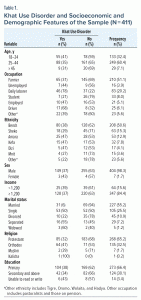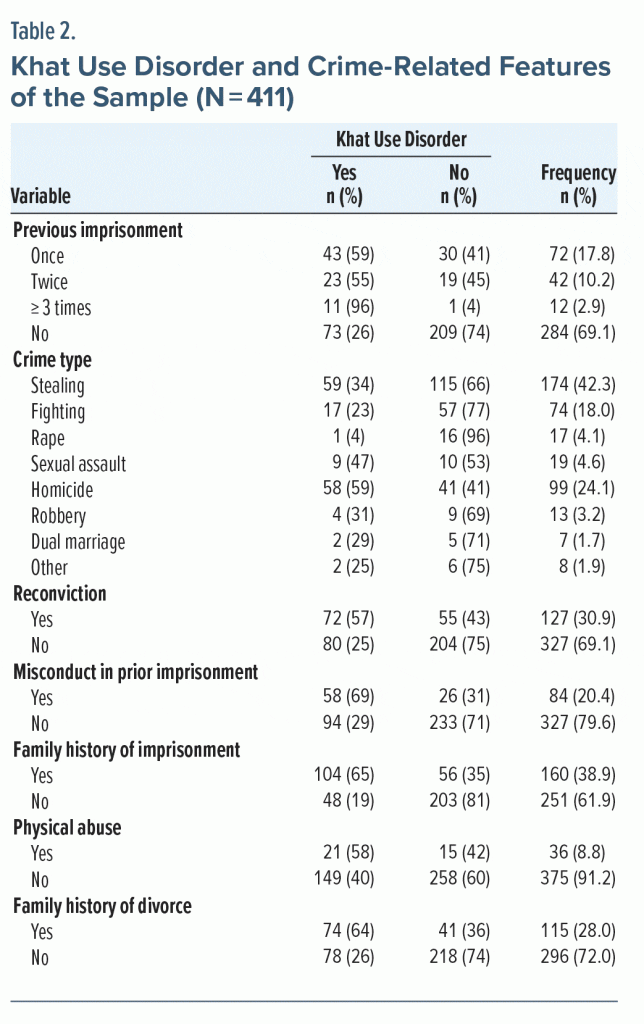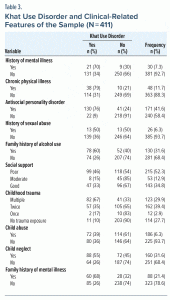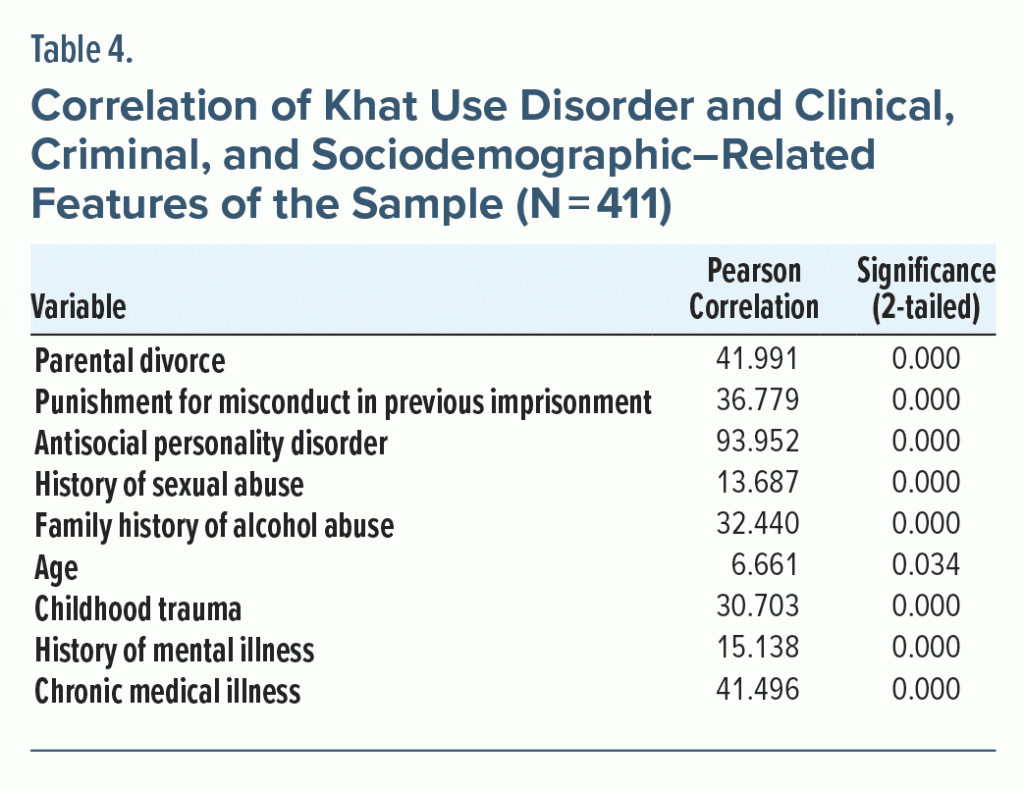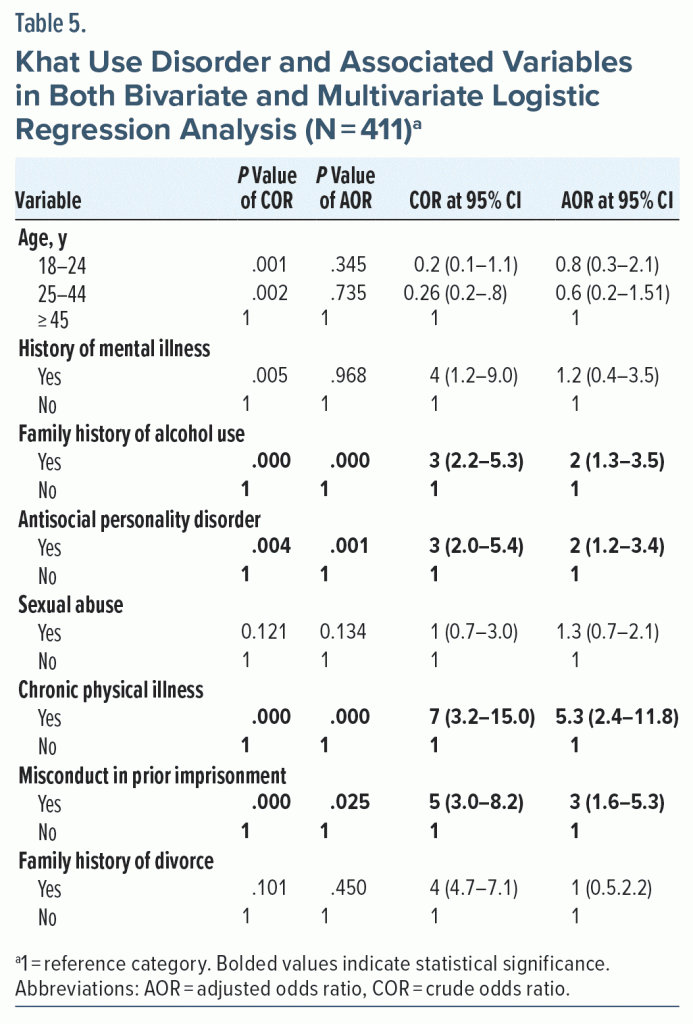ABSTRACT
Objective: To examine the relationship between khat use disorder and antisocial personality disorder in newly admitted inmates in a correctional facility in Ethiopia.
Methods: A cross-sectional study using successive sampling was conducted among 411 new inmates from April 20 to July 19, 2019. The Alcohol, Smoking, and Substance Involvement Screening Test was utilized to measure khat use. DSM-5 diagnostic criteria were used to identify antisocial personality disorder. Environmental, criminal, and clinical backgrounds of the inmates were also evaluated.
Results: The prevalence of current khat use and khat use disorder was 49.4% and 37%, respectively. The prevalence of khat use disorder among inmates with antisocial personality disorder was 76%. Inmates with antisocial personality disorder were twice as likely as those without antisocial personality disorder to have khat use disorder (adjusted odds ratio [AOR] = 2; 95% CI, 1.2–3.4). Punishment for misconduct in prior imprisonment (AOR = 3; 95% CI, 1.6–5.3), family history of alcohol use (AOR = 2; 95% CI, 1.3–3.5), and chronic physical illness (AOR = 5.3; 95% CI, 2.4–11.8) were significantly associated with khat use disorder.
Conclusions: The prevalence of khat use disorder was higher among inmates with antisocial personality disorder, and antisocial personality disorder is linked to khat use disorder. The findings of this study suggest the need for the establishment of a mental health system in all prison institutions in Ethiopia to enhance early screening for underlying medical conditions, history of substance use, and antisocial personality disorder. Those inmates with identified substance use need detoxification therapy and motivational interviews after prison admission.
Prim Care Companion CNS Disord 2023;25(5):22m03470
Author affiliations are listed at the end of this article.
Khat is an amphetamine-type plant with a psychomotor stimulant effect, native to Africa and the Arabian Peninsula.1 Khat is an illegal drug in most countries like Europe, Asia, and North America. Several countries such as the Netherlands, China, and the United Kingdom have listed khat as a controlled substance.2 In Ethiopia, most farmers’ livelihoods depend on khat. Khat has also become Ethiopia’s largest export after coffee, valued at 300 million US dollars in recent years, with about 90% of production being exported.3 Ethiopian law neither explicitly allows nor prohibits the cultivation, consumption, or sale of khat. Currently, the Ethiopian government has no clear legislation on khat use, sale, and production.4 Khat is available in 24-hour shops and markets. Khat leaves are usually sold in kilograms or bundles. The average cost ranges from 5 to 6 US dollars (250 Ethiopian birrs) per 1 kg.5 The amount of khat use can vary based on the severity of khat use disorder. Khat use is prohibited in Ethiopian prison systems.6
Khat contains diverse alkaloids, including cathinone, cathine, and ephedrine. Cathinone, which has the same molecular structure as amphetamine, is one of the key active components of khat. It causes khat-induced excitation, lack of appetite, sadness, and psychotic symptoms.7 Almost 10 million individuals ingest khat daily worldwide.8 An estimated 80%–90% of adult populations in East Africa chew khat daily, and khat use is common in western countries among immigrants.9,10 In Ethiopia, 12% of women and 27% of men chewed khat in 2016.9,10 Problematic use of khat is associated with mania with grandiose delusions, schizophreniform disorder with persecutory delusions and auditory hallucinations, suicidal and homicidal behaviors, and anxiety disorder.11–15 The chewing of khat can worsen symptoms in patients with psychiatric disorders.15
An antisocial personality disorder includes emotional, behavioral, and interpersonal impairment. Individuals with antisocial personality disorder cannot experience empathy, lack remorse, and exhibit impulsivity, stimulation seeking, and aggression.16,17 Antisocial personality disorder tends to co-occur with problematic substance use, and the antisocial personality trait can lead to increased substance use.18 Substance use is motivated by antisocial personality characteristics such as sensation seeking, poor social competence, neuroticism, impulsivity, and disobedience.19 Both khat use disorder and antisocial personality disorder were positively related to crime.20
Approximately one-third of untreated prisoners were found to have used drugs within 6 months after discharge.21 Problematic substance use is associated with reoffending, committing crime at an early age, and having more contact with the prison institution.22 A link was also discovered between drug use disorder and antisocial personality disorder, substance use disorder in family members, anxiety disorders, and exposure to physical, sexual, and emotional trauma.23,24 Furthermore, substance misuse before imprisonment was associated with the following factors: young age, male sex, urban dwelling, high educational status, poor physical health, more serious crime, and criminal recidivism.25–28 Mental illness was twice as common among prisoners with substance use disorder.29 Furthermore, studies30–32 revealed that substance misuse is associated with traumatic events, antisocial personality disorder, misconduct in jail, and a history of substance abuse by parents.
Substance misuse among inmates is a problem due to inadequate treatment in prison and lack of supervision after discharge, which enables them to commit repeated crimes and become readdicted.33,34 Motivational interviews and insight-oriented psychotherapy provided to offenders with substance use disorder was shown to be effective.35 Although drug use is common among inmates, the possible link between khat use disorder and antisocial personality disorder has yet to be investigated in Ethiopia or elsewhere. As a result, the purpose of this study was to examine the relationship between khat use disorder and antisocial personality disorder in newly admitted inmates at the Bench Sheko and West Omo Zone correctional institution in Mizan Aman, Ethiopia.
METHODS
This cross-sectional study was conducted from April 20 to July 19, 2019. The research region is in southwestern Ethiopia, located 565 km from Addis Ababa, which is Ethiopia’s capital city. The research region revolves around the Dima mining site in Gambella Regional State, which is a recognized substance use location, and most inmates have travelled to the mining site from other parts of Ethiopia. The detention facility serves the Bench, Sheko, Sheka, Surma, Dizi, Minit, Kefa, and other Ethiopian tribes. At the time of this study, the correctional institution had almost 2,000 inmates with no mental health clinician or facility.
The source population consisted of all new inmates in Ethiopia, whereas the study population consisted of all new inmates who satisfied the qualifying requirements at the time of data collection. Any new inmate admitted during the research period was included; however, those with life-threatening medical and mental illnesses and those aged < 18 years were excluded.
Sample Size Determination and Sampling Technique
The sample size was determined using the single population proportion formula, assuming a prevalence of 50%, since no similar study had been conducted in Ethiopia among new inmates. A 95% CI, margin of error (d = 0.05), and nonresponse rate of 10% were utilized. The total sample size was 422. A nonprobability consecutive sampling technique was used. Any newly admitted inmate participated in the study until the required number was obtained.
Procedure
A pretested semistructured questionnaire was used to collect sociodemographic, environmental, clinical, drug, and criminal data. The Alcohol, Smoking, and Substance Involvement Screening Test (ASSIST)36 was used to assess substance use disorder. The ASSIST tool was developed by the World Health Organization for use in sexually transmitted disease clinics and mental health service institutions and in high-risk substance use groups such as prisoners and sex workers. The sensitivity and specificity of ASSIST were 80–94 and 81–97, respectively, in low-income countries in Africa, including Ethiopia.36
Khat use was evaluated using an amphetamine version of the ASSIST tool; the sum of questions 2–7 provided a khat use risk score. Those who scored ≥ 27 were considered to have khat use disorder, and those who used khat in the past 3 months were current khat users.36 The reliability (Cronbach α) of this study was 0.90.
The explanatory variables used for khat use disorder were social support status, trauma exposure history, and antisocial personality disorder. Social support status was assessed using the standardized Oslo-3 Social Support Scale, which is classified into 3 categories: poor support, 3–8; moderate support, 9–11; and strong support, 12–14.37 Trauma exposure was assessed via the Life Events Checklist.38 An inmate was classified as positive for trauma if at least 1 trauma event was experienced or witnessed. The Life Events Checklist was developed by the US Department of Veterans Affairs National Center for Posttraumatic Stress Disorder to detect posttraumatic stress symptoms. It is used in cross-cultural settings and predicts substance use disorder, anxiety symptoms, depression, and posttraumatic stress disorder.38 If an inmate had ≥ 3 of 7 symptoms of antisocial personality in adulthood and ≥ 3 symptoms of childhood conduct disorder per DSM-5 criteria, they were considered positive for antisocial personality disorder.34,39
Furthermore, socioeconomic and demographic characteristics, environmental variables, clinical variables (history of mental illness, history of known medical disease, known familial mental illness, and history of family alcohol use), and crime-related variables were analyzed.
Clinicians with a mental health specialty served as data collectors and supervisors. A senior clinical mental health professional trained data collectors and supervisors on ASSIST and other methods to ensure data quality. Before collecting data, a standard for grading individual questionnaire items was verified. A structured locally translated Amharic version of the ASSIST questionnaire was also used to collect data. To reduce mistakes in the data collection tools, the pretest was conducted at a local jail facility with 5% of the needed sample size.
Data Analysis
The data were edited, coded, cleaned, and entered in EpiData version 3.1 before being exported to SPSS version 21 for analysis. Descriptive data such as frequency and percentage were utilized, as well as text and tables. To identify independent predictors for khat use disorder, logistic regression was employed. The multivariable logistic regression model included a variable with P < .25 on bivariate analysis. Independent variables were reported at P = .05, and the strength of the link was measured using an adjusted odds ratio (AOR) with a 95% confidence interval. In the multivariable logistic regression model, P < .05 was considered statistically significant.
Ethical Consideration
The procedure was carried out in conformity with the Helsinki declaration. The Jimma University Review Board provided the ethical clearance approval letter. The goal of the study was presented to the study participants when permission was granted by the jail administration. The participants’ written consent was then obtained before the interview. Participation was optional, and the freedom to decline participation was guaranteed. Confidentiality was strictly protected.
RESULTS
Sociodemographic and Economic Characteristics
Of 422 inmates, 411 participated in the study, with a response rate of 97.4%. The mean ± SD age of the participants was 29.24 ± 8.33. Almost all participants were male, and the most prevalent religion was Protestant. Most of the participants were of the same ethnicity. Table 1 provides sociodemographic statistics of the sample.
Prevalence of Khat Use Disorder
A total of 152 (37%) subjects had a history of khat use disorder, and 203 (49.4%) were current khat users. Also, 70 (17%) of the inmates had khat, alcohol, and cigarette use problems simultaneously, and 106 (26%) had ≥ 2 substance use disorders. Furthermore, 66 (16.1%) had an alcohol use disorder, 56 (13.6%) had a tobacco use disorder, and 210 (51.0%) had used at least 1 substance in the 3 months before their present incarceration. Khat and alcohol were the most utilized drugs among the respondents. Within the last 3 months, 203 (49.4%) had used khat, and 92 (22.1%) had used alcohol.
Khat Use Disorder and Crime-Related Factors
All participants had been convicted for at least 3 months; 247 (60%) and 31 (7.5%) of the participants were sentenced to ≤ 2 years in prison and life in prison, respectively. One-third of the participants (n = 127, 30.9%) were reconvicted inmates, of which 72 (57%) had khat use disorder. Over 90% of the inmates previously admitted to prison ≥ 3 times had khat use disorder. The most common reasons for imprisonment were theft (n = 174, 42.3%), murder (n = 99, 24.1%), and physical violence (n = 74, 18.0%). More than half of those convicted of theft or murder had khat use disorder. Of the overall participants, 160 (38.9%) had a criminal background, of which 104 (65.0%) had khat use disorder. Among the respondents, 84 (20.4%) had previously been imprisoned for misconduct. Detailed information on crime-related aspects of the respondents is provided in Table 2.
Khat Use Disorder and Clinically Related Factors
A total of 48 (11.7%) respondents had a follow-up history of chronic medical disease. The most often reported medical illnesses among incoming inmates were tuberculosis, HIV/AIDS, and epilepsy, and 79% (n = 38) with chronic medical illnesses had khat use disorder. Among the respondents, 30 (7.3%) reported being in follow-up for mental illness, and 21 (70%) of those individuals had khat use disorder. A quarter of the individuals (n = 88, 21.4%) reported a family history of mental illness or treatment. Almost one-third of the subjects (n = 130, 32%) claimed that their family members drank alcohol, of which 60% (n = 78/130) had khat use disorder. Also, 6.3% (n = 26) of all subjects had suffered sexual abuse, and 13 (50%) of those individuals had used khat. More than half of the respondents (n = 215, 52.3%) had a weak social network, and almost half of those individuals (n = 99, 46%) reported khat use disorder (Table 3).
Of the total respondents, 48 (11.7%) had a follow-up history of chronic medical illness. Tuberculosis, HIV/AIDS, and epilepsy were the most reported medical conditions among new prisoners, and 38 (79%) of those inmates had khat use disorder. Of the total respondents, 30 (7.3%) reported that they were in follow-up for mental illness, of which 21 (70%) had khat use disorder. Approximately one-fourth of the participants (n = 88, 21.4%) had a family history of mental illness and treatment. Almost one-third of the participants (n = 130, 32%) reported that their family members used alcohol, and 78 (60%) of those individuals had khat use disorder. Of the total participants, 26 (6.3%) had experienced sexual abuse, and 13 (50%) of those individuals had khat use disorder. More than half (n = 215, 52.3%) of the respondents were in the poor social network category, among which 99 (46%) had khat use disorder (Table 3).
Factors Associated With Khat Use Disorder
The bivariate analysis indicated that having divorced parents, receiving punishment for misconduct during previous imprisonment, age, follow-up history of medical illness, having alcoholic parents, having an antisocial personality disorder, history of childhood trauma exposure, having a mental illness, and history of sexual abuse were positively associated with khat use disorder. However, multivariable logistic regression showed that the following variables were positively and significantly associated with khat use disorder: punishment for misconduct in previous imprisonment (AOR = 3; 95% CI, 1.6–5.3), family history of alcohol use (AOR = 2; 95% CI, 1.3–3.5), chronic physical illness (AOR = 5.3; 95% CI, 2.4–11.8), and antisocial personality disorder (AOR = 2; 95% CI, 1.2–3.4) (Table 4 and Table 5).
DISCUSSION
The comorbidity of antisocial personality disorder and khat use disorder among newly admitted inmates in a correctional institution was investigated in this study. The frequency of khat use disorder was 76% among inmates with antisocial personality disorder.
In this study, antisocial personality disorder was substantially related to khat use disorder, with individuals with antisocial personality disorder being twice as likely to have khat use disorder as those without antisocial personality disorder. Research conducted in other regions of the world found drug use other than khat consumption to be related to antisocial personality disorder.40–45 A high proportion of the Ethiopian population uses khat daily for multiple purposes. Inmates with antisocial personality disorder might use khat as part of their pleasure-seeking or impulsive and risky behaviors (eg, making decisions without considering the consequences). Excessive use of khat might be due to poor impulse control, leading to risky behavior, including substance misuse. Impulsivity and risky behaviors among inmates with antisocial personality disorder might also extend the duration and amount of khat use, as these individuals often reject social norms and increase substance misuse by isolating themselves. In addition, inmates with an antisocial personality disorder may deny using a substance as part of their lying behavior, which might increase the intensity of risk associated with khat use, such as delay in treatment.46
As stated previously, the association between antisocial personality disorder and khat use disorder could be related to antisocial personality traits such as irresponsibility, impulsivity, and risk-taking behavior.47 Both antisocial personality disorder and amphetamine (khat) use disorder are known for sensation-seeking behavior, which enables individuals to misuse a substance without considering the related danger. Furthermore, use of an amphetamine drug such as khat during the early stage of brain development can cause severe brain damage that may predispose one to antisocial personality disorder.48 Khat use might also increase the probability of antisocial personality disorder by removing the individual from healthy social and family interactions.48
In this study, inmates with a chronic physical illness were 5 times more likely to have khat use disorder than their counterparts. This result is similar to that of a study from California.49 A possible explanation for this result may be that chronic pain and emotional distress due to the medical illness increase the risk of using khat as self-medication to temporarily alleviate pain.50 Khat use also might reduce the effectiveness of prescribed medications for the underlying medical illness.51 Use of a psychoactive substance increases the probability of transmission of communicable diseases due to unprotected sexual intercourse among khat users.52 Additionally, khat users might have decreased appetite, poor medication adherence, lack of follow-up treatment, and a direct physiologic effect of khat on the body system that increases the possibility of physical illness and the chance of infection. Moreover, using a combination of multiple substances would affect treatment outcomes. For example, use of khat and alcohol has the potential to affect the immunity of substance users, and vulnerable people could develop a series of adverse health effects.53–55
Those with a history of punishment for misconduct in prior imprisonment had higher odds of having khat use disorder than their counterparts. This result was similar to that of a study conducted in a US Midwestern state.30 Prisoners with khat use disorder may try to escape from correction institutions to obtain khat due to their strong desire and need to relieve withdrawal symptoms, and they may be punished for their misconduct repeatedly while in prison as a result.
Prisoners with family members who abused substances were about 3 times more likely to develop khat use disorder than their counterparts. This finding is similar to that of a study conducted in Lebanon.31 This association could be due to the hereditary and environmental susceptibilities of participants to substance use disorder. It is known that specific gene expression exposes individuals to substance use disorders. The genetic alteration could be inherited from one generation to another, which could be the reason for the positive association of family history of substance use with khat use disorder in this study.56,57 In addition, khat abuse is a behavior that can be acquired from environmental exposure and easily learned by family members and via peer pressure.58
Limitations
This is the first study, to our knowledge, to explore the incidence of khat use disorder and its association with antisocial personality disorder among Ethiopian inmates. This study did not address the cause-effect link between khat use disorder and antisocial personality disorder. Chronic physical sickness, family history of drug use, past punishment for misbehavior while incarcerated, and antisocial personality disorder were all linked to khat use disorder. However, to grasp the results, the scientific community must first understand some of the following limitations. Participants may deny history of khat use due to interviewer and recollection bias. Because the number of female inmates is small, generalization is difficult. Medical records were not reviewed to establish the inmates’ physical and mental illnesses. Furthermore, the results do not extend to inmates who had spent a significant amount of time in a prison. Further longitudinal research is needed to show a cause-effect link between antisocial personality disorder and khat use disorder.
CONCLUSION
Khat use disorder was predominant among newly admitted prisoners with antisocial personality disorder. Punishment for misconduct in previous imprisonment, family history of alcohol use, chronic medical illness, and antisocial personality disorder were positively associated with khat use disorder. Therefore, more intensive treatment is recommended to avoid life-threatening substance-related complications at the time of prison admission. Implementation of a mental health system in all prison institutions in Ethiopia us recommended for detoxification therapy, and motivational interviews for prisoners with substance use disorders should be conducted shortly after admission to the correctional facility. In addition, underlying medical conditions, history of substance use, and antisocial personality disorder should be screened and managed accordingly shortly after admission to the correctional facility before life-threatening conditions occur.
Article Information
Published Online: October 17, 2023. https://doi.org/10.4088/PCC.22m03470
© 2023 Physicians Postgraduate Press, Inc.
Submitted: December 19, 2022; accepted May 17, 2023.
To Cite: Wolde A, Kassaw C, Tessema SA. Association of khat use disorder and antisocial personality disorder among inmates in Ehiopia: a cross-sectional study. Prim Care Companion CNS Disord. 2023;25(5):22m03470.
Author Affiliations: Department of Psychiatry, School of Medicine, Mizan Tepi University, Mizan Aman, Ethiopia (Wolde); Department of Psychiatry, School of Medicine, Dilla University, Dilla, Ethiopia (Kassaw); Department of Psychiatry, St. Paul Hospital Millennium Medical College, Ethiopia (Tessema).
Corresponding Authors: Chalachew Kassaw, MSC, Department of Psychiatry, Dilla University, Dilla, Ethiopia ([email protected]); Selamawit Alemayehu Tessema, MD, MPH, Department of Psychiatry, St. Paul Hospital Millennium Medical College ([email protected]; [email protected]).
Relevant Financial Disclosure: None.
Funding/Support: None.
Acknowledgments: The authors are grateful to the study respondents, Jimma University, and others who helped during the study.
CLINICAL POINTS
- Khat use disorder was predominant among newly admitted inmates with antisocial personality disorder.
- Early screening for underlying medical conditions, history of substance use, and antisocial personality disorder is needed for newly admitted inmates.
- Implementation of a mental health system in all Ethiopian prison institutions for detoxification therapy is recommended, in addition to motivational interviews for inmates with substance use disorder.
References (58)

- Toennes SW, Harder S, Schramm M, et al. Pharmacokinetics of cathinone, cathine and norephedrine after the chewing of khat leaves. Br J Clin Pharmacol. 2003;56(1):125–130. PubMed CrossRef
- Griffiths P, Lopez D, Sedefov R, et al. Khat use and monitoring drug use in Europe: the current situation and issues for the future. J Ethnopharmacol. 2010;132(3):578–583. PubMed CrossRef
- Gebissa E. Scourge of life or an economic lifeline? public discourses on khat (Catha edulis) in Ethiopia. Subst Use Misuse. 2008;43(6):784–802. PubMed CrossRef
- Tolcha PT. Khat marketing and its export performance in the Ethiopian economy. Strateg Bus Change Manag. 2020;7(2):58–69.
- Ageely HM. Health and socio-economic hazards associated with khat consumption. J Family Community Med. 2008;15(1):3–11. PubMed CrossRef
- Dessie G. Is Khat a Social ILl? Ethical Argument About a Stimulant Among the Learned Ethiopians. Leiden, African Studies Center; 2013.
- Naugle DK. Reordered Love, Reordered Lives: Learning the Deep Meaning of Happiness. Wm. B. Eerdmans Publishing; 2008.
- Al-Maweri SA, Warnakulasuriya S, Samran A. Khat (Catha edulis) and its oral health effects: an updated review. J Investig Clin Dent. 2018;9(1):e12288. PubMed CrossRef
- Warfa N, Klein A, Bhui K, et al. Khat use and mental illness: a critical review. Soc Sci Med. 2007;65(2):309–318. PubMed CrossRef
- Central Statistical Agency (CSA)[Ethiopia] and The DHS Program ICF. Ethiopia Demographic and Health Survey. Addis Ababa, Ethiopia and Calverton, Maryland:2016.
- Hassan NA, Gunaid AA, Murray-Lyon IM. Khat (Catha edulis): health aspects of khat chewing. East Mediterr Health J. 2007;13(3):706–718. PubMed
- Alsanosy RM, Mahfouz MS, Gaffar AM. Khat chewing among students of higher education in Jazan region, Saudi Arabia: prevalence, pattern, and related factors. BioMed Res Int. 2013;2013:487232. PubMed CrossRef
- Odenwald M, Neuner F, Schauer M, et al. Khat use as risk factor for psychotic disorders: a cross-sectional and case-control study in Somalia. BMC Med. 2005;3(1):5. PubMed CrossRef
- Odenwald N, Lingenfelder B, Peschel W. Psychotic disorder, khat abuse and aggressive behavior in Somalia: a case report. Afr J Drug Alcohol Stud. 2008;7(1):46361.
- Pennings EJ, Opperhuizen A, van Amsterdam JG. Risk assessment of khat use in the Netherlands: a review based on adverse health effects, prevalence, criminal involvement and public order. Regul Toxicol Pharmacol. 2008;52(3):199–207. PubMed CrossRef
- Lykken DT. Psychopathy, sociopathy, and antisocial personality disorder. Handbook of Psychopathy. 2018;23:22.
- Hare R. Technical Manual for the Revised Psychopathy Checklist. North Tonawanda, NY: Multi-Health Systems; 2003.
- Clifton A, Pilkonis PA, McCarty C. Social networks in borderline personality disorder. J Pers Disord. 2007;21(4):434–441. PubMed CrossRef
- Widiger TA, Lynam DR. Psychopathy and the five-factor model of personality. In: Millon T, Simonsen E, Birket-Smith M, eds. Psychopathy: Antisocial, Criminal, and Violent Behavior. The Guilford Press; 1998:171–187.
- Hemphill JF, Hare RD, Wong S. Psychopathy and recidivism: a review. Leg Criminol Psychol. 1998;3(1):139–170. CrossRef
- Pelissier B, Wallace S, O’Neil JA, et al. Federal prison residential drug treatment reduces substance use and arrests after release. Am J Drug Alcohol Abuse. 2001;27(2):315–337. PubMed CrossRef
- Grann M, Danesh J, Fazel S. The association between psychiatric diagnosis and violent re-offending in adult offenders in the community. BMC Psychiatry. 2008;8(1):92. PubMed CrossRef
- Hoss A. Decriminalization as substance use disorder prevention. U Tol L Rev. 2019;51:477.
- Reardon ML, Lang AR, Patrick CJ. An evaluation of relations among antisocial behavior, psychopathic traits, and alcohol problems in incarcerated men. Alcohol Clin Exp Res. 2002;26(8):1188–1197. PubMed CrossRef
- Robertson G. Correlates of crime among women offenders. Med Sci Law. 1990;30(2):165–174. PubMed CrossRef
- Plant G, Taylor PJ. Recognition of problem drinking among young adult prisoners. Behav Sci Law. 2012;30(2):140–153. PubMed CrossRef
- Hammersley R, Forsyth A, Morrison V, et al. The relationship between crime and opioid use. Br J Addict. 1989;84(9):1029–1043. PubMed CrossRef
- Aromäki AS, Lindman RE. Alcohol expectancies in convicted rapists and child molesters. Crim Behav Ment Health. 2001;11(2):94–101. PubMed CrossRef
- Gates ML, Turney A, Ferguson E, et al. Associations among substance use, mental health disorders, and self-harm in a prison population: examining group risk for suicide attempt. Int J Environ Res Public Health. 2017;14(3):317. PubMed CrossRef
- Connor DP, Tewksbury R. Inmates and prison involvement with drugs: examining drug-related misconduct during incarceration. J Contemp Crim Justice. 2016;32(4):426–445. CrossRef
- Yazbek J-C, Haddad R, Bou Khalil R, et al. Prevalence and correlates of alcohol abuse and dependence in Lebanon: results from the Lebanese Epidemiologic Survey on Alcohol (LESA). J Addict Dis. 2014;33(3):221–233. PubMed CrossRef
- Levin Y, Lev Bar-Or R, Forer R, et al. The association between type of trauma, level of exposure and addiction. Addict Behav. 2021;118:106889. PubMed CrossRef
- Algul A, Ates M, Semiz U, et al. P0036-Relationship of substance use disorder to aggression in male subjects with antisocial personality disorder. Eur Psychiatry. 2008;23(S2):S91. CrossRef
- Roberts A, Hayes AJ, Carlisle J, Shaw J. Review of Drug and Alcohol Treatments in Prison and Community Settings. A Systematic Review Conducted on Behalf of the Prison Health Research Network. 2007. Accessed September 18, 2023. https://citeseerx.ist.psu.edu/document?repid=rep1&type=pdf&doi=4a347d902324fd95b713e6a2e3ae3e85cbd26c78
- Rounds-Bryant JL, Baker L Jr. Substance dependence and level of treatment need among recently incarcerated prisoners. Am J Drug Alcohol Abuse. 2007;33(4):557–561. PubMed CrossRef
- McNeely J, Strauss SM, Wright S, et al. Test-retest reliability of a self-administered Alcohol, Smoking and Substance Involvement Screening Test (ASSIST) in primary care patients. J Subst Abuse Treat. 2014;47(1):93–101. PubMed CrossRef
- Kocalevent R-D, Berg L, Beutel ME, et al. Social support in the general population: standardization of the Oslo Social Support Scale (OSSS-3). BMC Psychol. 2018;6(1):31. PubMed CrossRef
- Weathers F, Blake D, Schnurr P, et al. The Life Events Checklist for DSM-5 (LEC-5). National Center for PTSD website. 2013. Accessed September 18, 2023. https://www.ptsd.va.gov
- Sadock BJ, Sadock VA, Ruiz P. Obsessive-Compulsive and Related Disorders. Synopsis of Psychiatry: Behavioral Sciences/Clinical Psychiatry. 11th ed. Baltimore: Williams & Wilkins; 2015:418–426.
- Mueser KT, Crocker AG, Frisman LB, et al. Conduct disorder and antisocial personality disorder in persons with severe psychiatric and substance use disorders. Schizophr Bull. 2006;32(4):626–636. PubMed CrossRef
- Mueser KT, Gottlieb JD, Cather C, et al. Antisocial personality disorder in people with co-occurring severe mental illness and substance use disorders: clinical, functional, and family relationship correlates. Psychosis. 2012;4(1):52–62. PubMed CrossRef
- Thapa P, Mishra SR, Pandey AR, et al. Prevalence and predictors of alcohol consumption among the squatter of Kathmandu Valley. J Nepal Health Res Counc. 2016;14(32):18–26. PubMed
- Slade K, Forrester A. Measuring IPDE-SQ personality disorder prevalence in pre-sentence and early-stage prison populations, with sub-type estimates. Int J Law Psychiatry. 2013;36(3-4):207–212. PubMed CrossRef
- Marco A, Antón JJ, Saiz de la Hoya P, et al; PERSEO Group. Personality disorders among Spanish prisoners starting hepatitis C treatment: prevalence and associated factors. Psychiatry Res. 2015;230(3):749–756. PubMed CrossRef
- Black DW, Gunter T, Loveless P, et al. Antisocial personality disorder in incarcerated offenders: psychiatric comorbidity and quality of life. Ann Clin Psychiatry. 2010;22(2):113–120. PubMed
- Macciò A, Meloni FR, Sisti D, et al. Mental disorders in Italian prisoners: results of the REDiMe study. Psychiatry Res. 2015;225(3):522–530. PubMed CrossRef
- Sun L, Han X, Wang K, et al. Candidate symptomatic markers for predicting violence in schizophrenia: a cross-sectional study of 7711 patients in a Chinese population. Asian J Psychiatr. 2021;59:102645. PubMed CrossRef
- Kotamarti VS, North CS, Pollio DE. Adult antisocial behavior and its relationship to the diagnosis of antisocial personality disorder in a longitudinal study of homelessness. J Soc Distress Homeless. 2021;30(1):20–27. CrossRef
- Chesher NJ, Bousman CA, Gale M, et al. Chronic illness histories of adults entering treatment for co-occurring substance abuse and other mental health disorders. Am J Addict. 2012;21(1):1–4. PubMed CrossRef
- Garland EL, Froeliger B, Zeidan F, et al. The downward spiral of chronic pain, prescription opioid misuse, and addiction: cognitive, affective, and neuropsychopharmacologic pathways. Neurosci Biobehav Rev. 2013;37(10 Pt 2):2597–2607. PubMed CrossRef
- Schulte MT, Hser Y-I. Substance use and associated health conditions throughout the lifespan. Public Health Rev. 2014;35(2):3. PubMed CrossRef
- El-Bassel N, Shaw SA, Dasgupta A, et al. Drug use as a driver of HIV risks: re-emerging and emerging issues. Curr Opin HIV AIDS. 2014;9(2):150–155. PubMed CrossRef
- Alvi A, Rizwan M, Sunosi RA, et al. Does khat chewing increases the risk of mycobacterium tuberculosis infection by macrophage immune modulation? Med Hypotheses. 2014;82(6):667–669. PubMed CrossRef
- Ranzani OT, Rodrigues LC, Bombarda S, et al. Long-term survival and cause-specific mortality of patients newly diagnosed with tuberculosis in São Paulo state, Brazil, 2010–15: a population-based, longitudinal study. Lancet Infect Dis. 2020;20(1):123–132. PubMed CrossRef
- Corkery JM, Schifano F, Oyefeso A, et al. Overview of literature and information on “khat-related” mortality: a call for recognition of the issue and further research. Ann Ist Super Sanita. 2011;47(4):445–464. PubMed
- Schuckit MA. An overview of genetic influences in alcoholism. J Subst Abuse Treat. 2009;36(1):S5–S14. PubMed
- Li MD, Burmeister M. New insights into the genetics of addiction. Nat Rev Genet. 2009;10(4):225–231. PubMed CrossRef
- Birhanu AM, Bisetegn TA, Woldeyohannes SM. High prevalence of substance use and associated factors among high school adolescents in Woreta Town, Northwest Ethiopia: multi-domain factor analysis. BMC Public Health. 2014;14(1):1186. PubMed CrossRef
Please sign in or purchase this PDF for $40.
